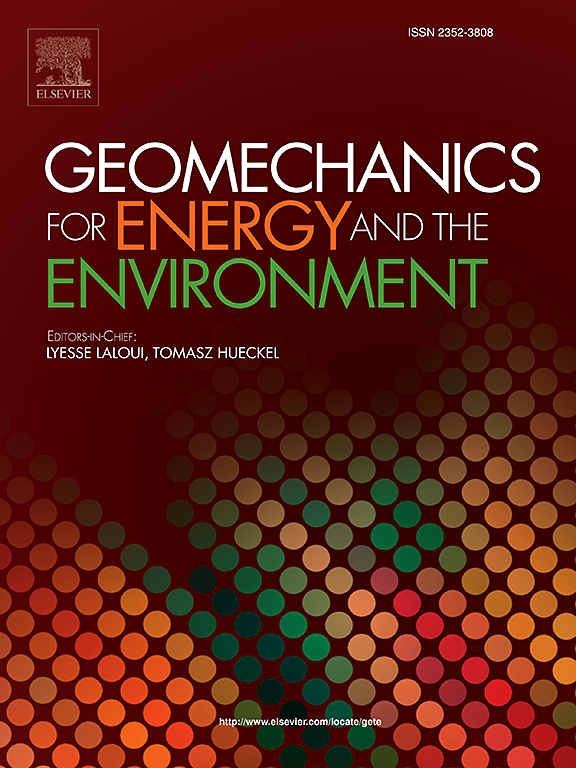Numerical simulation of solute transport in argillaceous rock under thermal gradient with a coupled THM-solute transport model
IF 3.3
2区 工程技术
Q3 ENERGY & FUELS
引用次数: 0
Abstract
Argillaceous rocks have many favourable characteristics for deep geological disposal of high-level radioactive waste (HLW) such as low permeability resulting in slow solute transport dominated by diffusion processes. However, waste-generated heat can increase pore pressure through Thermal-Hydraulic-Mechanical (THM) coupled processes, potentially enhancing advective transport. In this study, the authors developed a mathematical model to simulate a laboratory and a large-scale in situ experiment at an underground research facility (URF), to investigate (1) T-solute transport coupling (via the Soret effect and temperature-dependent diffusion coefficient) and (2) THM-solute transport coupling in argillaceous rock. The findings suggest that the Soret effect is significant in the laboratory experiments with relatively high thermal gradient, but negligible in the URF experiment where the thermal gradient is much smaller. Instead, the effect of temperature on the diffusion coefficient appears to play a more crucial role for the URF experiment. In addition, the advection enhancement due to thermal pressurization as a result of THM processes shows an insignificant effect on solute transport. The modelling of the URF experiment, as confirmed by observational evidence, shows the importance of anisotropy of the THM-transport properties as well as the effects of the excavation damage zone (EDZ). Finally, the model captures the key features of both experiments, highlighting its capability in enhancing comprehension of transport processes from a deep geological repository (DGR) built in argillaceous rocks. This improved understanding is valuable for safety assessments of DGRs in such rock types.
基于thm -溶质输运耦合模型的热梯度下泥质岩石溶质输运数值模拟
泥质岩具有低渗透性、溶质运移缓慢、扩散等特点,适合于高放废物的深层地质处置。然而,废物产生的热量可以通过热-液压-机械(THM)耦合过程增加孔隙压力,从而潜在地增强平流运输。在这项研究中,作者建立了一个数学模型来模拟实验室和地下研究设施(URF)的大规模原位实验,以研究(1)t -溶质输运耦合(通过Soret效应和温度相关扩散系数)和(2)泥质岩石中thm -溶质输运耦合。研究结果表明,Soret效应在热梯度较大的实验室实验中显著,但在热梯度较小的URF实验中可以忽略不计。相反,温度对扩散系数的影响似乎在URF实验中起着更重要的作用。此外,由于THM过程引起的热加压导致的平流增强对溶质输运的影响不显著。实验模拟结果表明,三次元输运特性的各向异性以及开挖损伤区(EDZ)的影响具有重要意义。最后,该模型捕获了两个实验的关键特征,突出了其在增强对泥质岩石中深层地质储存库(DGR)运输过程的理解方面的能力。这一改进的认识对于在此类岩石类型中进行dgr的安全性评估是有价值的。
本文章由计算机程序翻译,如有差异,请以英文原文为准。
求助全文
约1分钟内获得全文
求助全文
来源期刊

Geomechanics for Energy and the Environment
Earth and Planetary Sciences-Geotechnical Engineering and Engineering Geology
CiteScore
5.90
自引率
11.80%
发文量
87
期刊介绍:
The aim of the Journal is to publish research results of the highest quality and of lasting importance on the subject of geomechanics, with the focus on applications to geological energy production and storage, and the interaction of soils and rocks with the natural and engineered environment. Special attention is given to concepts and developments of new energy geotechnologies that comprise intrinsic mechanisms protecting the environment against a potential engineering induced damage, hence warranting sustainable usage of energy resources.
The scope of the journal is broad, including fundamental concepts in geomechanics and mechanics of porous media, the experiments and analysis of novel phenomena and applications. Of special interest are issues resulting from coupling of particular physics, chemistry and biology of external forcings, as well as of pore fluid/gas and minerals to the solid mechanics of the medium skeleton and pore fluid mechanics. The multi-scale and inter-scale interactions between the phenomena and the behavior representations are also of particular interest. Contributions to general theoretical approach to these issues, but of potential reference to geomechanics in its context of energy and the environment are also most welcome.
 求助内容:
求助内容: 应助结果提醒方式:
应助结果提醒方式:


